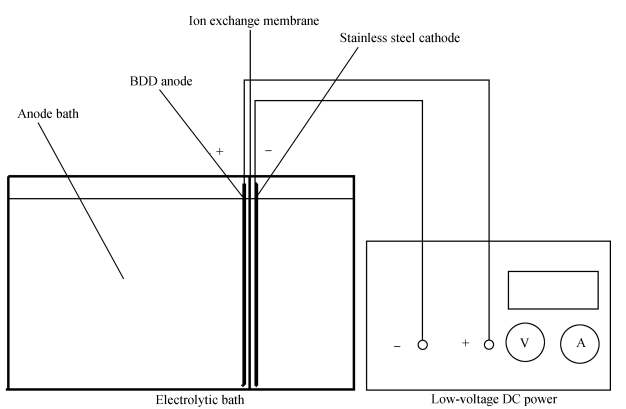Abstract: This paper presents a new cleaning process using boron-doped diamond (BDD) film anode electrochemical oxidation for metallic contaminants on polished silicon wafer surfaces. The BDD film anode electrochemical oxidation can efficiently prepare pyrophosphate peroxide, pyrophosphate peroxide can oxidize organic contaminants, and pyrophosphate peroxide is deoxidized into pyrophosphate. Pyrophosphate, a good complexing agent, can form a metal complex, which is a structure consisting of a copper ion, bonded to a surrounding array of two pyrophosphate anions. Three polished wafers were immersed in the 0.01 mol/L CuSO4 solution for 2 h in order to make comparative experiments. The first one was cleaned by pyrophosphate peroxide, the second by RCA (Radio Corporation of America) cleaning, and the third by deionized (DI) water. The XPS measurement result shows that the metallic contaminants on wafers cleaned by the RCA method and by pyrophosphate peroxide is less than the XPS detection limits of 1 ppm. And the wafer’s surface cleaned by pyrophosphate peroxide is more efficient in removing organic carbon residues than RCA cleaning. Therefore, BDD film anode electrochemical oxidation can be used for microelectronics cleaning, and it can effectively remove organic contaminants and metallic contaminants in one step. It also achieves energy saving and environmental protection.
The dual-Damascene process is widely used nowadays in the semiconductor industryŒ1. In this process, copper has progressively replaced aluminum for the fabrication of interconnections in integrated circuits (ICs)Œ2. This switch emerged due to copper’s advantageous characteristics, such as low resistivity and high immunity to electro-migration, which in turn results in greater circuit reliability and markedly higher clock frequency. Chemical–mechanical planarization (CMP) has become an essential step in Damascene processing of copper interconnect structuresŒ3. CMP has many advantages, including surface planarization, reduced process steps and thermal budgetŒ4; 5. However, it will induce metal and organic contamination residues on the dielectric material surface. The control of metallic residues after CMP is getting more emphasis in advanced interconnects. Cleaning efficiency and the removal of metallic contaminations have a significant impact on productivity and reliability. A major reliability issue is dielectric degradation caused by Cu-ion drift. Because of its quick diffusion through SiO2 and Si, and the formation of acceptor and donor levels within the forbidden band-gap, Cu needs to be cleaned after the CMP process.
A polished wafer was immersed in pyrophosphate peroxide solution for 10 min, and then rinsed with fresh DI water. After that the wafer was ultrasonically cleaned at a frequency of 80 kHz for 10 min. In the final step, the wafer was dried in a nitrogen atmosphere.

Fig1
The second wafer was immersed for 10 min in RCA (SC1) solution (NH4OH (29%) ∶ H2O2 (30%) ∶ H2O in a volume ratio of 1 W 1 W 5) at a temperature of 80 ıC. After ultrasonic cleaning at a frequency of 80 kHz for 10 min, the wafer was immersed in RCA (SC2) solution (HCl (37%) ∶ H2O2(30%) ∶ H2O in a volume ratio of 1 W 1 W 6) at a temperature of 70 ıC, for 10 min. Then the wafer was ultrasonically cleaned at a frequency of 80 kHz for 10 min after rinsing with DI water. In the final step, the wafer was dried in a nitrogen atmosphere.
BDD film anode electrochemical oxidation can efficiently prepare pyrophosphate peroxide, pyrophosphate peroxide can oxidize organic contaminantsŒ14, and pyrophosphate peroxide is deoxidized into pyrophosphate. Pyrophosphate, a kind of good complexing agent, is able to control metal ion contaminants on a wafer’s surface. Therefore, BDD film anode electrochemical oxidation can be used for microelectronics cleaning, and it can effectively remove organic contaminants and metallic contaminants in one step. It also achieves energy saving and environmental protection.
上一篇: 碳化硅太阳能电池的湿式化学处理